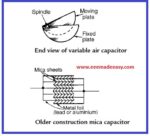Deputy Engineer Electrical Syllabus Kerala PSC: DETAILED SYLLABUS FOR THE POST OF DEPUTY ENGINEER (ELECTRICAL) IN KERALA CO-OPERATIVE MILK MARKETING FEDERATION LIMITED/ AND ASSISTANT ENGINEER (ELECTRICAL) KSEB
(Cat.No.: 220/2021, 221/2021, 493/2022) (Total 100 marks)
Join EEE Made Easy Telegram channel
1.Electric Circuits – (10 marks)
Kirchoff’s laws – maximum power transfer theorem. Star/delta transformation. Energy stored in a capacitor and inductor. Analysis of coupled circuits – dot polarity convention – sinusoidal steady state analysis of coupled circuits. Generation of alternating voltages and currents – rms value, average value, peak factor, form factor. AC through series R, L, C circuit – series resonance- resonant power – bandwidth. Resonance in parallel circuits.
2.Magnetic Circuits (10 marks)
Absolute and relative permeability of a medium – Magnetic field strength- magnetic potential. Relation between magnetism and electricity – Series and parallel magnetic circuits with composite materials. Faraday’s laws of electromagnetic inductionLenz’s law – statically and dynamically induced emf.
3. Electrical Machines (10 marks)
DC Generators- Constructional details, working principle – types of dc generators –
emf equation – power stages – condition for maximum efficiency. DC motor – armature control and field control. Single phase transformer – working principle, equivalent circuit, losses in a transformer, condition for maximum efficiency. Three phase transformer – construction- difference between power transformer and distribution transformer. Alternators- constructional details –Synchronous motor – starting methods – synchronous condenser. Three phase induction motor – working ,principle, constructional details – slip, torque and current equations – torque- speed curve. Special Electrical Machines: Types and applications.
4. Digital Electronics – (10 marks)
Number Systems and Codes: Binary, Octal and hexadecimal conversions- ASCII code, Excess -3 code, Gray code. Combinational circuits – Adders – Full adder and half adder. Multiplexers- Demultiplexers. Flipflops – registers – counters. Digital – to – Analogue and Analogue-to-Digital conversion. Microprocessors – Internal architecture of 8085 microprocessor–Functional block diagram Instruction set – Addressing modes – Classification of instructions – Status flags. Machine cycles and T states – Fetch and execute cycles- Timing diagram.
5. Power Systems – (10 marks)
Line parameters -resistance- inductance and capacitance. Insulators –string efficiency corona. Circuit breakers: rating, types. CTs – PTs – Relays – types. Per unit quantities- symmetrical components – symmetrical and unsymmetrical fault. Power system stability – steady state, dynamic and transient stability-power angle curve – Load Flow analysis – Gauss Siedal, Newton Raphson, Fast decoupled load flow.
Download & Install EEE Made Easy App
6. Control Systems- (10 marks)
Transfer function of LTI systems – block diagram reduction – Signal flow graph – Mason’s gain formula – Type and Order of the systems- Characteristic equation Time domain specifications of transient and steady state responses- Impulse and Step responses of first order and second order systems. Static error coefficients of type 0,1,2 systems. Routh’s stability criterion. Frequency domain specifications. Polar plot and Bode plot – concepts of gain margin and phase margin- stability analysis.
7. Power Electronics and Operational Amplifiers- (10 marks)
SCR- Structure, Static characteristics. Fully controlled and half controlled bridge rectifier with R, RL and RLE loads. Voltage Source Inverters– 1-phase half-bridge & full bridge inverter with R and RL loads – Three phase inverter – Pulse width modulation. Single quadrant, Two quadrant and Four quadrant chopper. Operational Amplifiers – fundamental differential amplifier- Modes of operation. Properties of ideal and practical Op-amp – gain, CMRR and slew rate.
8. Measurements and Instrumentation (10 marks)
Measurement standards – errors – Types of Errors. Classification of instruments, secondary instruments–indicating, integrating and recording. Ammeters and voltmeters – moving coil, moving iron. Measurement of power: Dynamometer type wattmeter –Construction and working – Three phase power measurement – single wattmeter and two wattmeter methods. Measurement of energy – Single phase energy meter – construction and working. Digital Energy meters –Time of Day(TOD) meters.
Oscilloscopes- principle of operation of general purpose CRO-basics of vertical and
horizontal deflection system.
9. Signals and Systems (10 marks)
Classification of signals – Elementary signals- Basic operations on continuous time and discrete time signals. Concept of systems – Classification of systems- Properties of systems – Time invariance- Linearity -Causality – Memory – Stability. Sampling process – Impulse train sampling – sampling theorem- Aliasing effect. Zero order and First order hold circuits.
10. Transducers, Batteries, Electrical wiring (10 marks)
General classification- LVDT- angular displacement transducers- hall effect transducers. Batteries – Primary cells– secondary cells- battery ratings- grouping of cells. Wiring – systems of wiring- rules for domestic wiring. Earthing- types of earthing – rules for earthing. Illumination – Laws of illumination. Electric lamps – different types.
Download Syllabus
Join EEE Made Easy Whatsapp Channel
Best Books for KSEB AE Exam
- Assistant Engineer Electrical KSEB Books list
- Question Bank In Electrical Engineering (Fully Solve With Explanations)
- Kerala PSC OBJECTIVE ELECTRICAL ENGINEERING
- PSC PREVIOUS QUESTION AND ANSWERS IN ELECTRICAL / ELECTRONICS ENGINEERING
- Best Books for Assistant Professor in Electrical and Electronics Engineering|Best Books for Kerala PSC Assistant Professor Electrical Engineering
Latest Posts in EEE Made Easy
- RRB JE CBT 2 Exam Date 2025 Postponed|RRB JE CBT 2 Exam Date
- [PDF]RRB JE Result 03/2024 Cut off, Selected no of candidates for all regions
- [PDF]Final Answer Key Junior Instructor Mechanic Agricultural Machinery|643/2023 Solved Question paper
- Acoustics MCQs|Industries Extension officer|IEO 2025
- LASER MCQs| Industries Extension officer|IEO 2025
- Practical Types of Capacitors
- [PDF] Syllabus JUNIOR INSTRUCTOR MECHANIC AGRICULTURAL MACHINERY|643/2023 Syllabus Kerala PSC




